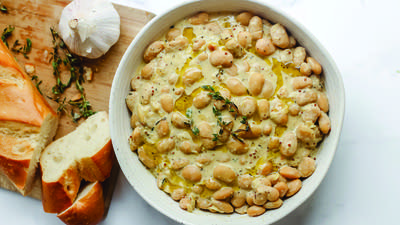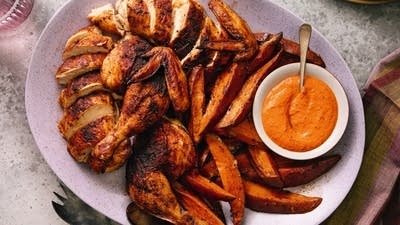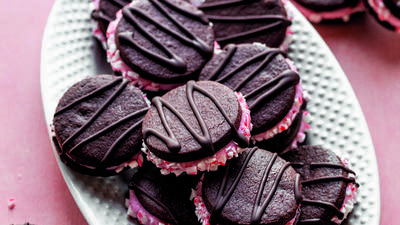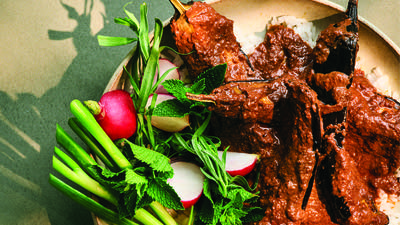
The unfortunate reality about seeds is that most are not bred and selected for flavor. Rather, they are chosen specifically for the yield, uniformity and shelf stability of their fruit or vegetable. Chef Dan Barber wants to change that. The chef-owner of Blue Hill and Blue Hill at Stone Barns wants to help create seeds that bring forth new foods with unexpected and unique flavors. Which is why he - along with seedsman Matthew Goldfarb and seed breeder Michael Mazourek - cofounded of a new seed company called Row 7. They work directly with professional chefs, who give guidance on what flavors to breed for in their vegetables. Barber explained to Francis Lam that this type of partnership could change how and what we all eat. See the Cook + Grow section of Row 7's website for more information on growing and cooking with their unique produce.
Francis Lam: We talk a lot about knowing where your food comes from. I credit you for a lot of that, the way we think about that as a chef. Because you're a chef who, famously, has a restaurant on a farm, and you bring products from the field directly to the table, you bring the dirt from the farm to the table, and you help us reinforce this idea of where our food comes from. For most of us, what that means is: Who's your farmer? Who's the person growing that food? And a lot of us, absolutely me included, don't take that one step further back to ask where do the seeds that those farmers grow come from? Who are the seed breeders? Where do they work?
Dan Barber: This is a late inning revelation for me too. I wasn't asking those questions until one night about nine years ago when a group of breeders from Cornell University came for dinner. I went out to the table in the dining room and I found them to be engaging and articulate. One of them asked questions like he was thinking like a chef creating a recipe. I wanted to talk more to this guy. His name was Michael Mazourek. He came into the kitchen at the end of the meal, and we got into a discussion, this banter, it was late at night, and there was a cook that was prepping a butternut squash in front of us for the next day. Michael is a squash breeder. I said, “If you're such a great squash breeder, why don't you figure out how to make a butternut squash taste good? Instead of chefs doing these heroics of roasting, caramelizing, adding maple syrup and gastriques, just create the thing and make it great.” And what he said to me was probably what changed my appreciation for the work that breeders do and also got me thinking about how to engage them more. He said that in all of his years of breeding, no one had ever asked him to select for flavor. I thought that was nuts. Who was he talking to?
Of course, in the years that followed, I learned exactly who these breeders are talking to, which is the large industrial food chain, which for the most part dictates how our seeds are selected and how they're going to be grown. We think of the farming system as the template, but it's the seed that's the template; it’s the blueprint. These breeders are creating the architecture for how we eat in the future and they are not talking to chefs like me or concerned, informed eaters like you, even though we do represent a growing dynamic cohort of well-educated people who demand flavor in their food and want to know more about it. The end result of that conversation was the realization that we need to engage breeders because we need a seat at that table. Walmart has a seat at the table; we don't have a seat at the table.
 Chef Dan Barber (far right) with Row 7 cofounders seedsman Matthew Goldfarb (far left) and seed breeder Michael Mazourek.
(Photos: Johnny Autry)
Chef Dan Barber (far right) with Row 7 cofounders seedsman Matthew Goldfarb (far left) and seed breeder Michael Mazourek.
(Photos: Johnny Autry)
FL: To your point, industrial producers need things bred for shelf life, they need things bred for storability, they need things bred for a certain size.
DB: Yield is a big one. These are all determining factors. What you just listed, those are the top three. By definition, if you're selecting for those three things, you're selecting against flavor and nutrition. One of the great moments for me along the continuum of learning about this is the correspondence between flavor and nutrition. Nutrient density and flavor are the same thing; flavonoids are flavor. You literally cannot have a jaw-droppingly delicious carrot without a nutrient dense carrot. It's one and the same thing.
FL: You're starting this company to, as you put it, get chefs at the table with these breeders and help them think about the possibilities of flavor. But, what does that mean? You're not saying, “Could you grow me a watermelon that tastes like great bubblegum?”
DB: That's not the point of the company. But if that is the north star of a chef, then I just I don't know. My point is I don't want to shut out possibilities. The suite of possibilities is endless, as breeders have taught me. You need to ask, and they never get asked. What they get asked for are shelf life, uniformity, and yield. The food culture, as it were, is demanding uniformity. It's also demanding a seed that will grow similarly here in the Hudson Valley as it will in Southern California, as it will in Texas, as it will in Mexico, Canada, and China. That's how seeds are developed these days, with a one size fits all approach.
What if we both, A, put flavor and nutrition where it should be, at the top of the list of priorities, and, B, also recognize that there are vastly different ecologies, geographies, cultural entanglements and histories that we should play into this breeding selection – and all of a sudden, you start to see very differentiated possibilities for the same seed as well as different seeds. What's beautiful about seeds throughout history is that that they evolved through this beautiful correspondence between the ecological realities of where they were grown and the cultural realities, and they evolved out of each other. That's what's so beautiful about chefs, it seems to me, and the way food culture's headed, which is to advertise a sense of place, to tether it to history, to acknowledge some of the environmental conditions, and to riff on that. That is where great food is headed.
 The female flower of an experimental cucumber begins to produce fruit
. Photos: Johnny Autry
The female flower of an experimental cucumber begins to produce fruit
. Photos: Johnny Autry
FL: Let's talk about these seeds. You have seven different seeds growing for, obviously, seven different plants. I was reading their descriptions and they sound –
DB: Delicious?
FL: Delicious, but in some ways fantastic. In some ways, I can't even imagine them. You have a cucumber with fragrance that fills the room. A cucumber is like the most generic, dumb-dumb vegetable. You have your dumb salad and your dumb cucumber.
DB: Right, and that's what we use in our restaurants, unfortunately, because we're sort of forced into that. I did a very deep, delicious dive into the history of cucumbers. What I learned is that cucumbers, first of all, do you know cucumber is poisonous? The original cucumber is poisonous, so what we're eating is a weird genetic thing that happened to the cucumber. All of a sudden there was a cucumber that arrived in the world that did not kill you when you ate it. There are stories about who ate that first cucumber, and it was animals. People recognized that they were eating something that didn't kill them, and from there breeding of cucumber happened. Essentially, when you ate it, it was so bitter that it was unpalatable. What happened through the thousands of years of breeding is it became more and more sweet, because you were selecting for that sweetness. And then, the Dutch got it in their hands and it went totally to water, sugar, and sweetness and really bland, which is what you're describing what we live off today. Dutch cucumbers taste like nothing. Especially the way they're grown in hothouses, it's just a blank slate.
But the original heirlooms, the older varieties, have quite a bit of bitterness to them. They don't kill you, but they tingle and they have a depth of flavor that's exciting. All chefs are after that exciting flavor. We don't look for that kind of sweetness; we're looking for the depth of flavor, and that's what you get in these little varieties. So, we took an old heirloom and mixed it with some of the modern varieties, and it turns out – the most fascinating thing for me out of all this – within the genetic traits that give you that bitterness, it's a very complex cucumber. It’s not what you're used to for cucumber. It's strikingly delicious and memorable. It also happens to have a kind of disease resistance in the field that most cucumbers don't have, especially to this thing called powdery mildew, which is a terrible fungus for organic cucumber growers. By luck more than conscious plan, we were after the flavor, but it turns out that it's a very strong plant, and to grow it organically with these genetics is actually much easier. The yield is good, the disease resistance is good, and the flavor and nutrition are off the charts, and that encapsulates what we're trying to do at the company.
FL: I want to talk about another one of your seeds. Actually I could sit here and talk about all of them. You know, you have squashes that turn color when they are ripe so you know when to pick them. That's amazing. But I want to talk to you specifically about the Habanada pepper. So this is –
DB: Can I interrupt you? I want to underscore what you just said. A squash that you pick when it's ripe. Let’s stop on that one. The squash industry picks 99.9 percent of squash when it's unripe. And that's the problem with the adding the sugar and the maple syrup and the caramelizing because the squash is not ripe. We just don't demand ripe squash.
FL: We don't even think of the ripeness of squash.
DB: Right. The breeder put in a ripeness indicator so it will be green which indicates very quickly that it's not ripe. With the way squash is grown right now, it looks fully ripe but inside it's completely green. He's reversed it and selected for the gene that makes you know when it's ripe. And, therefore, it's like a vine ripened tomato. You cannot pick it off the vine until it's ripe and that assures a kind of flavor complexity, deliciousness, and sweetness that one can only dream of. It's just that little trick, but, again, he turned to me and said nobody's asked me to do that. Because the industry wants to pick it green.
FL: Right.
DB: Okay, so we're going to change the squash culture. Sorry I interrupted you with that.
FL: It's like a turkey timer. Bing! It's done.
DB: And it assures a kind of flavor that you wouldn't get.
 The flamed-color Badger Flame Beet (left) is mild and sweet and deliberately lacking in beets' signature earthiness. The heatless Habanada Pepper captures the floral and melon-like flavors of the famous habanero, minus the burn.
(Text from Row 7. Photos by Johnny Autry)
The flamed-color Badger Flame Beet (left) is mild and sweet and deliberately lacking in beets' signature earthiness. The heatless Habanada Pepper captures the floral and melon-like flavors of the famous habanero, minus the burn.
(Text from Row 7. Photos by Johnny Autry)
FL: Let's talk about the Habanada pepper. It’s a habanero mutation?
DB: Well, it's selected. This is the same breeder, Michael Mazourek, the guy who came into my kitchen who is from Cornell. Brilliant breeder and he loves peppers, but he can't stand heat. That's where it started. The habanero for him is the most delicious, exquisite pepper in the world, but the breeding has gone toward the heat because Americans want heat – hot, blasting, overwhelming heat. And he's like, “You are dissing what habanero really wants to be, which is floral and beautiful and lovely and sweet.” So, he selected against the heat and, after seven years, created a pepper that he called Habanada; it is completely absent of heat.
FL: Oh, wow! But it has those incredibly heavy floral flavors.
DB: Floral. Yeah. It tastes like a melon. It's incredible. It gets you to think about a pepper in a whole new way. And you look at it and you think this is going to blow my mouth apart. It also gets you to think about how seeds spread. Chickens and fowl ate this hot stuff, but they didn't taste heat. That's how peppers spread – through fowl. They would eat, they didn't get affected by the heat, and then they'd poop out the seed in some other place. That’s how peppers spread throughout the world.
FL: They could fly!
 Learn more about growing Row 7's 898 Squash and how to make Dan Barber's recipe for 898 Puree and Squash Skin Crumble at the Row 7 website.
(Photos: Johnny Autry)
Learn more about growing Row 7's 898 Squash and how to make Dan Barber's recipe for 898 Puree and Squash Skin Crumble at the Row 7 website.
(Photos: Johnny Autry)
FL: I want to talk about this word “heirloom” that you bring up. I think a lot of us when we think of the idea of older seeds, the difference between doing what you're doing now and just getting older seeds is that those older seeds will have things like low yield. They will produce fruit that may be delicious but may have low yield and you're crossing them to make them.
DB: Yes. We're taking what we love about them but making them appropriate to place. Remember, heirlooms are coming from somewhere else. You grow an heirloom here in the Hudson Valley, it wasn't bred in the Hudson Valley, it was bred in France or Italy or China or India, whatever the vegetable is. So just by first stroke, by putting it in the ground you're making a compromise. It's a plant that was bred somewhere else. Now, that doesn't mean it's going to fail and it doesn't mean that it won't be delicious; it just means that it could be so much more delicious and productive if you selected for its particular environment. That's what we're doing.
FL: With the ecosystem.
DB: And make it viable, not just for me and my white tablecloth cathedral of a restaurant. Because that's the other problem with this, is these tastes and these flavors that I am so excited about should not be in the –
FL: The realm of the $300 tasting menu.
DB: Yeah. Why? We tend to think that it's either that or Monsanto maniacs on the other side. And that's crazy. We can democratize this and make this into very affordable, delicious, nutritious food, if we ask breeders for it. And we have to ask. We want chefs at the table because they curate the stuff every night and they should be a part of the conversation. The reason I love chefs so much is not just because I wear a white coat myself, but because we are ambassadors of flavor. And by virtue of being ambassadors of flavor we are ambassadors of nutrition. One and the same thing. Remember that. That is a key component of this. And if you add in the regionalism, the possibility for expression of place, you get a very dynamic and interesting food culture for the future. But, it has to start with seeds.
Before you go...
Each week, The Splendid Table brings you stories that expand your world view, inspire you to try something new, and show how food connects us all. We rely on your generous support. For as little as $5 a month, you can have a lasting impact on The Splendid Table. And, when you donate, you’ll join a community of like-minded individuals who love good food, good conversation, and kitchen companionship. Show your love for The Splendid Table with a gift today.
Thank you for your support.
Donate today for as little as $5.00 a month. Your gift only takes a few minutes and has a lasting impact on The Splendid Table and you'll be welcomed into The Splendid Table Co-op.




